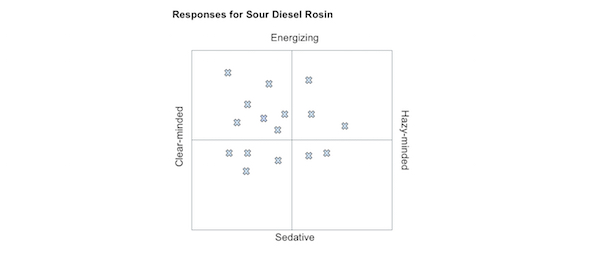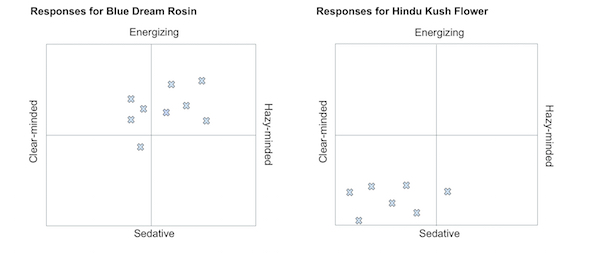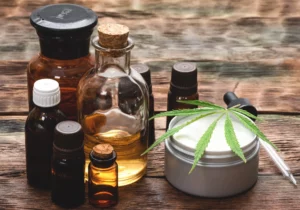Let’s face it: As much as we can classify cannabis strains and chemical compounds by their effects on the consumer, individuals can still have wildly varying experiences. One person can be affected one way, while another person can be affected in an entirely different way, despite controlling for all other factors including dosage, route of administration, timing and more.
In this article, part of a series for cannabis newcomers, we turn to the phenomenology of cannabis—meaning, how cannabis makes people feel. If you’ve ever read about or been described the effects of a particular marijuana strain only to have a completely different experience when consuming it, read on.
FOLLOW US ON FACEBOOK & INSTAGRAM
Playing the Cannabis Lottery
When I first started using cannabis, it felt like I was playing some kind of lottery. I would go to the dispensary looking for a marijuana strain that would make me feel relaxed, happy and pain-free. Each time, I would read about the strain or maybe talk to a friend or budtender to get recommendations. “Oh, this one is great for relaxing,” they would tell me.
But later, at home, I would try each cannabis strain, wondering if any of them would work the way I was told they would. What I usually found was that most of these strains produced the exact opposite effect. I would find myself anxious and unfocused instead of happy and relaxed.
Of course, every so often, I would find what I was looking for—a marijuana strain that eased my pain and anxiety. With these strains, I felt great. My head was clear, my body was finally free from chronic pain, and I felt, well, like myself.
At first, I was frustrated with the people giving me what seemed like bad marijuana strain advice. “That strain isn’t relaxing at all!” I would complain to my husband. “That budtender didn’t know what he was talking about.”
But as I began to better understand the many complex variables involved with cannabis use, I also began to understand that it wasn’t that the strain alone was an anxiety-inducer; it was the combination of the strain and my biochemistry that was making it so. In fact, the marijuana strains that are most likely to send me into an anxious downward spiral are the same ones that some of my best friends use to manage their anxiety.
As it turns out, cannabis strains affect people in a variety of ways, and they don’t affect everyone in the same way. Or as one of my favorite budtenders used to say, “Different strains for different brains.”
I realized that I didn’t need to find the strains that were being touted as relaxing. What I needed to find were the strains that were most relaxing for me. This meant a careful and systematic tracking of what was working for me—and what wasn’t. Eventually, I honed in on the genetic varieties that suit my personal biochemistry, thus producing the effects that I was looking for.
I’m not alone in having very specific tastes in cannabis. According to HelloMD’s 2016 Patient Survey, 86% of cannabis consumers have a strong preference for a particular cannabis strain, while 87% of patients say they only use one to three products on a regular basis.
It’s also not uncommon that it will take some time finding the products that work best. Over 50% of survey respondents said they managed to find a product that solved their medical concerns in less than one month of looking. However, 21% took up to three months while 27% took longer than six months to find what worked best for them.
RELATED: HOW TO FIND YOUR IDEAL MARIJUANA DOSAGE
Researching How People Feel When They Consume Cannabis
Many years after my first experiments trying to find the right cannabis strains for me, I had the opportunity to run product development and testing for a cannabis brand. My doctoral work and academic expertise had focused on analyzing various scientific methods for assessing subjective factors like happiness, pain or well-being.
When I shifted my focus from academic work to cannabis product research, I began applying these scientific methods to consumer research problems—such as how to write more accurate descriptions of a cannabis product’s effects. Essentially, I began researching how different cannabis products affected how people feel. Here are a few things I learned from the data I collected.
1. Cannabis Product Effects Vary Person to Person
One thing the research showed was that the perceived effects of a cannabis product could vary widely from person to person. In our testing, we used a grid where consumers could indicate how sedative vs. energetic a particular product was as well as how clear-minded vs. hazy the product made them feel. In these tests, we’d frequently see responses in every quadrant of the chart. The exact same product might be considered sedative or energetic, make them feel hazy or clear-headed, depending on the person describing it. Many products had a wide range of variety in reported effects. It turns out that brands and dispensaries can’t write a perfectly accurate description of their product’s effects. Bottom line: No description will be true for everyone.

2. Statistical Trends Can Be Found in Cannabis Phenomenology
While we saw a variety in the reported effects of any given cannabis product, we also found statistical trends. For example, our Hindu Kush products tended to be rated as sedative, while making folks feel clear-minded. Meanwhile, our Blue Dream products were rated as making folks feel energized and hazy. While we saw some variety in the responses, we were also able to glean a statistically average response for each product.
The statistically average response was then used to create a product description. While this meant that the majority of folks would find the effects they experience to jibe with the description, it still meant there’d be consumers who’d strongly disagree with it. While the descriptions best fit the data, they still weren’t perfect descriptions for everyone.

3. Some Cannabis Consumers Have Consistently Atypical Reactions
If you find that you’re one of those people who often disagrees with the descriptions you find on the products you buy, you—like me—may have atypical reactions to cannabis varieties. I started out by looking for strains that would energize and relax me. Because I was looking for energy, I was pointed towards a lot of sativa varieties. However, sativas just made me anxious.
Later, I tried smoking more indicas and found that these were the cannabis strains that actually gave me energy. A strain like Afgoo would fill me with relaxed energy, and yet most consider this to be a sedative strain. Sativas, while energetic, made me jittery and gave me headaches, which ended up draining any energy I had. When I started recording these reactions and comparing them to our product testing results, I found that my reactions were consistently atypical—but in a way I could count on.
I learned the marijuana strains, cannabinoids and terpenes that correlated to being energizing for me. And I stopped relying on the descriptions. Now, it’s quite easy for me to find strains that work, because I know what to expect and focus on. Now, I look for cannabis strains that are described as sedative, because those are typically the products that give me energy. By making this change, I’ve greatly improved my own success in getting products that do what I want them to do.
If you find your reactions are atypical, start testing out your own cannabis products and recording the effects. Once you can pinpoint the trends in your own cannabis reactions, you’ll be much better able to determine which product is right for you.
More Research Needed on the Phenomenology of Cannabis
My personal research was based on small sample sizes and products from only a few brands. More research is needed to truly understand the phenomenology of cannabis as well as the many factors involved. Hopefully, the data I’ve shared can help give a glimpse of the ways cannabis products can affect people in very different ways.
In the next several installments of the Cannabis for Newbies guide, we’ll shift gears to talk about the many ways cannabis is used to help treat various medical conditions. We’ll delve into the research and share success stories from individual patients. First up: cannabis as an aid in reducing anxiety.
Photo credit: Jurassic Blueberries
Need a medical marijuana recommendation? Consult with one of HelloMD’s knowledgeable doctors; it’s easy, private and 100% online.






